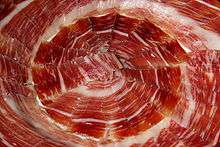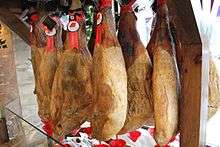Jamón serrano
 Jamón serrano presentation | |
| Course | Appetizer |
|---|---|
| Place of origin | Spain |
| Serving temperature | Cold |
| Main ingredients | Ham |
| Variations | Jamón ibérico |
|
| |

Jamón serrano (Spanish: [xaˈmon seˈrano]; "Serrano ham", literally "ham from the sierra, or mountains") is a type of jamón (dry-cured Spanish ham), which is generally served in thin slices, or occasionally diced.
The majority of serrano hams are made from the landrace breed of white pig and are not to be confused with the much more expensive jamón ibérico.
Preparation
Fresh hams are trimmed and cleaned, then stacked and covered with salt for about two weeks in order to draw off excess moisture and preserve the meat from spoiling. The salt is then washed off and the hams are hung to dry for about six months. Finally, the hams are hung in a cool, dry place for six to eighteen months, depending on the climate, as well as the size and type of ham being cured. The drying sheds (secaderos) are usually built at higher elevations, which is why the ham is called "mountain ham".
Availability
The majority of serrano hams are made from the landrace breed of white pig and are not to be confused with the much more expensive and entirely different jamón ibérico. These hams were known as a delicacy even in the days of the Roman Empire. Though not expensive in Spain and the European Union, duties imposed on imported meats and exchange rates makes these hams more costly outside the EU. Where available, the meat can usually be purchased sliced, in chunks, or as a complete, bone-in ham.
Jamón serrano has TSG Status.[1] The TSG certification attests that a particular food product objectively possesses specific characteristics which differentiate it from all others in its category, and that its raw materials, composition or method of production have been consistent for a minimum of 30 years.[2]
%2C_which_is_generally_served_in_thin_slices.jpg)
Other hams
There are many producers of Spanish hams but the level of quality can be judged by the following:
- The type of pig
- The way the pig has been fed
- The part of the pig used to make the ham
- The way the ham is cured
The four major quality categories of cured ham are as follows, from highest to lowest quality:
- Jamón ibérico de bellota: Free-range, acorn-fed Iberian pigs
- Jamón ibérico de recebo: Acorn, pasture and compound-fed Iberian pigs
- Jamón ibérico de campo (sometimes just jamón ibérico in short and also known as jamón de pata negra): Compound-fed Iberian pigs. Pata negra (literally black hoof), which only accounts for about five percent of total ham production, is made from the Black Iberian pig (cerdo ibérico). The best varieties of pata negra are range fed and fattened on acorns in holm oak groves along the southern border between Spain and Portugal. (See the two subcategories above)
- Jamón serrano (also known as jamón reserva, jamón curado and jamón extra): Compound-fed white pigs.
 A regional variation of jamón serrano.
A regional variation of jamón serrano.
See also
- Ham, particularly the section on Spain
- Jamón
- Jamón ibérico
- List of dried foods
References
- ↑ EC PDO/PGI/TSG List
- ↑ Tosato, Andrea (2013). "The Protection of Traditional Foods in the EU: Traditional Specialities Guaranteed". European Law Journal. 19 (4): 545–576. doi:10.1111/eulj.12040. Retrieved 22 May 2013.
External links
| Wikimedia Commons has media related to Jamón serrano. |